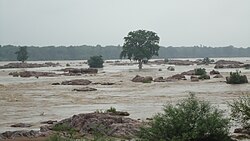Ken River
| Ken River | |
|---|---|
 Ken river | |
| Location | |
| Country | India |
| State | Madhya Pradesh, Uttar Pradesh |
| Region | Bundelkhand |
| Physical characteristics | |
| Source | Ahirgawan |
| • location | Kaimur Range, Katni district, Madhya Pradesh |
| • elevation | 550 m (1,800 ft) |
| Mouth | Yamuna River |
• location | Chilla Ghat, Banda district, Uttar Pradesh |
• coordinates | 25°46′N 80°31′E / 25.767°N 80.517°E |
| Length | 427 km (265 mi) |
| Discharge | |
| • average | 310 m3/s (11,000 cu ft/s)[1] |
The Ken River is one of the major rivers in the Bundelkhand region of central India and flows through the states of Madhya Pradesh and Uttar Pradesh. It is a tributary of the Yamuna.
Course
[edit]The Ken River originates near the village Ahirgawan on the north-west slopes of Barner Range in Katni district[2] and travels a distance of 427 km, before merging with the Yamuna at Chilla village, district Banda in Uttar Pradesh at 25°46′N 80°31′E / 25.767°N 80.517°E
Ken has an overall drainage basin of 28,058 km2, out of which 12,620 km2 belong to Sonar River its largest tributary, whose entire basin lies in Madhya Pradesh; and along its 427 kilometres (265 mi) course it receives water from its own tributaries such as Bawas, Dewar, Kaith and Baink on the left bank, and Kopra and Bearma of the right. Out of its total length of 427 kilometres (265 mi) it flows for 292 kilometres (181 mi) in Madhya Pradesh, 84 kilometres (52 mi) in Uttar Pradesh, and 51 kilometres (32 mi) forms the boundary between the two states.[3][4]
Crossing the Bijawar-Panna hills, the Ken River cuts a 60 km long, and 150–180 m deep gorge. Several streams join the Ken in this gorge making waterfalls. The Ken valley separates the Rewa Plateau from the Satna Plateau.[5]
References
[edit]- ^ "Hydrology" (PDF). nwda.gov.in. National Water Development Authority. Retrieved 22 April 2014.
- ^ "Chapter 2 – Physical Features" (PDF). Archived from the original (PDF) on 7 November 2007. Retrieved 15 July 2010.
- ^ Jain, Sharad K.; Pushpendra K. Agarwal; Vijay P. Singh (2007). Hydrology and water resources of India- Volume 57 of Water science and technology library - Tributaries of Yamuna river. Springer. p. 354. ISBN 978-1-4020-5179-1.
- ^ "A Watershed" (PDF). Envis Madhya Pradesh. Archived from the original (PDF) on 21 July 2011. Retrieved 15 July 2010.
- ^ Sharma, Shri Kamal (2000). Spatial framework and economic development. Northern Book Centre. ISBN 9788172111113. Retrieved 11 July 2010.
{{cite book}}:|work=ignored (help)
